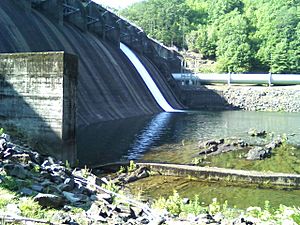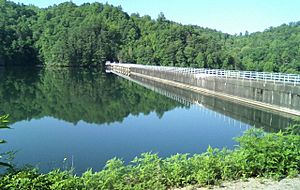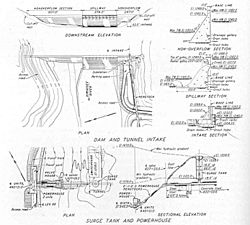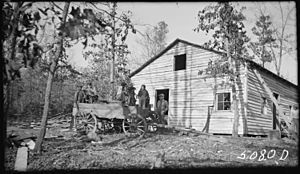Apalachia Dam facts for kids
Quick facts for kids Apalachia Dam |
|
|---|---|
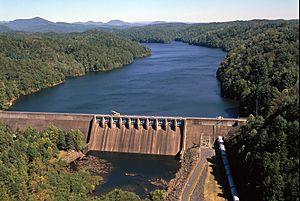 |
|
| Official name | Apalachia Dam |
| Location | Cherokee County, North Carolina, United States |
| Coordinates | 35°10′4″N 84°17′44″W / 35.16778°N 84.29556°W |
| Construction began | July 17, 1941 |
| Opening date | February 14, 1943 |
| Operator(s) | Tennessee Valley Authority |
| Dam and spillways | |
| Impounds | Hiwassee River |
| Height | 150 ft (46 m) |
| Length | 1,308 ft (399 m) |
| Reservoir | |
| Creates | Apalachia Reservoir |
| Total capacity | 57,800 acre⋅ft (71,300 dam3) |
| Catchment area | 1,018 sq mi (2,640 km2) |
Apalachia Dam is a large hydroelectric dam located on the Hiwassee River. It is found in Cherokee County, North Carolina, in the U.S. state of North Carolina. This dam is the lowest of three dams on the river. The Tennessee Valley Authority (TVA) owns and runs all three dams.
The TVA built Apalachia Dam in the early 1940s. Its main purpose was to create emergency power. This power was needed to make aluminum during World War II. Even though the dam is in North Carolina, its power plant is in Polk County, Tennessee. An 8.3-mile (13.4 km) underground pipe carries water from the dam's lake to this power plant. The dam and its related buildings were added to the National Register of Historic Places in 2017.
The dam gets its name from a small community called Old Apalachia. This community was near the dam site in North Carolina. There was also a train stop called Apalachia on the Tennessee side of the state line.
Contents
Where is Apalachia Dam Located?
Apalachia Dam is about 66 miles (106 km) upstream from where the Hiwassee River ends. The river flows through Northern Georgia and Western North Carolina. It then empties into Chickamauga Lake in East Tennessee. The dam sits in a beautiful, quiet valley. This valley was carved by the river as it flows through the Blue Ridge Mountains.
The Unicoi Mountains are to the north of the dam. The Nantahala National Forest surrounds the dam and its lake.
The power plant for Apalachia Dam is located 12 miles (19 km) downstream from the dam. It is at the bottom of a deep gorge. This gorge was formed by the river flowing between two mountains. The dam's 8.3-mile (13.4 km) water pipe is mostly underground. Only about 1,600 feet (490 m) of it is above ground. It runs behind the cliffs on the south side of the river.
How Apalachia Dam Works
Apalachia Dam is a concrete structure. It is 150 feet (46 m) high and 1,308 feet (399 m) long. The dam can produce 93,600 kilowatts of electricity. The dam has 10 gates that control water flow. These gates can release 136,000 cubic feet per second (3,900 m3/s) of water.
Apalachia Lake stretches for 9.8 miles (15.8 km) up to Hiwassee Dam. It has 31 miles (50 km) of shoreline. The lake covers 1,070 acres (430 ha) of water surface.
A 900-foot (270 m) steel pipe, called a penstock, connects the lake to the long 8.3-mile (13.4 km) underground pipe. This long pipe comes out of a cliff near the power plant. It then splits into two smaller tunnels. These tunnels carry water to a valve house. From the valve house, the water drops 200 feet (61 m) through two more steel pipes. These pipes lead to the turbines in the power plant below. The total drop in height from the lake to the power plant is between 394 feet (120 m) and 436 feet (133 m). This depends on how full the lake is.
Building Apalachia Dam
People knew about the power potential of the Hiwassee River since the early 1900s. The U.S. Army Corps of Engineers found possible dam sites, including Apalachia, in the 1920s. By the time the Tennessee Valley Authority (TVA) was created in 1933, some companies had already bought land in the Hiwassee Valley.
TVA started building dams in the valley. They built Hiwassee Dam in the late 1930s. By 1941, World War II had started in Europe. This caused a huge need for electricity, especially to make aluminum in the Tennessee Valley. So, TVA quickly planned to build several new dams, including Apalachia. All these dams were approved on July 16, 1941. Work on Apalachia Dam began the very next day.
To build Apalachia Dam and its lake, TVA had to buy 4,500 acres (1,800 ha) of land. Most of this land belonged to three private companies. Later, one company sold TVA another 8,100 acres (3,300 ha). This made the total area much larger. The land for the long water pipe was given by the U.S. Forest Service. Since most of the land was owned by companies, only 22 families and 2.4 miles (3.9 km) of roads needed to be moved.
The long water pipe was important. It allowed the dam to use the 12-mile (19 km) stretch of river downstream. In this area, the river drops about 26 feet (7.9 m) per mile. Workers built the tunnel for the pipe by blasting and using a special drill. A 235-foot (72 m) surge tank was dug into the rock near the valve house.
Apalachia Dam was finished on September 15, 1942. Its gates were closed on February 14, 1943. The water tunnel was completed on April 1, 1943. The dam's first generator started working on September 22, 1943. A second one began on November 17 of the same year. The whole project cost a bit over $24 million.
Ecology and Nature
Building the Apalachia Dam changed the natural flow of water in the Hiwassee River. This change caused a plant called Ruth's golden aster to decline. Because of this, the plant was put on the Endangered Species List in 1985.


